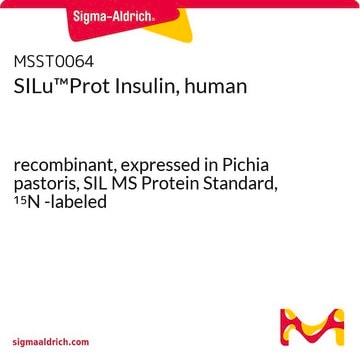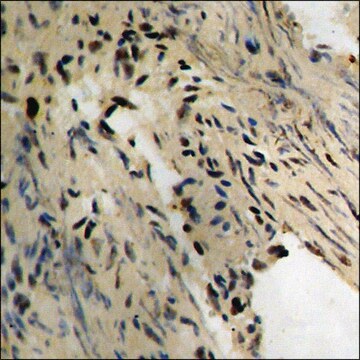MABN2275
Anti-phospho-Tau (Ser235) Antibody, clone RN235
clone RN235, from mouse
Synonym(e):
Microtubule-associated protein tau, Neurofibrillary tangle protein, Paired helical filament-tau, PHF-tau
About This Item
Empfohlene Produkte
Biologische Quelle
mouse
Antikörperform
purified immunoglobulin
Antikörper-Produkttyp
primary antibodies
Klon
RN235, monoclonal
Speziesreaktivität
mouse, human
Verpackung
antibody small pack of 25 μg
Methode(n)
ELISA: suitable
dot blot: suitable
immunofluorescence: suitable
immunohistochemistry: suitable (paraffin)
western blot: suitable
Isotyp
IgG1κ
NCBI-Hinterlegungsnummer
UniProt-Hinterlegungsnummer
Posttranslationale Modifikation Target
phosphorylation (pSer235)
Angaben zum Gen
human ... MAPT(4137)
Allgemeine Beschreibung
Spezifität
Immunogen
Anwendung
Neurowissenschaft
Dot Blot analysis: A representative lot detected phosphorylated recombinant human tau (pSer235), but not the non-phosphorylated recombinant human tau (Tau). (Courtesy of Rebecca Nisbet, Ph.D., University of Queensland, Brisbane, Austraila).
Immunofluorescence Analysis: A representative lot detected phospho-tau (Ser235) in K3 and rTg4510 tau transgenic mouse brains (Courtesy of Rebecca Nisbet, Ph.D., University of Queensland, Brisbane, Austraila).
Immunohistochemistry (Paraffin) Analysis: A representative lot detected phospho-Tau (Ser235) in human Alzheimer s disease (AD) brain tissue sections. (Courtesy of Rebecca Nisbet, Ph.D., University of Queensland, Brisbane, Austraila).
ELISA Analysis: A representative lot full-length human recombinant phospho-tau (Ser235) or GSK-3 beta phosphorylated tau (pTau), but not the non-phosphorylated tau (Courtesy of Rebecca Nisbet, Ph.D., University of Queensland, Brisbane, Austraila).
Western Blotting Analysis: A representative lot detected phospho-tau (pSer235) K3 tau transgenic mouse brain homogenates, but not in homogenates from tau knock-out (KO) (Courtesy of Rebecca Nisbet, Ph.D., University of Queensland, Brisbane, Austraila).
Qualität
Western Blotting Analysis: 2 µg/mL of this antibody detected Microtubule-associated protein tau (pSer235) in brain tissue lysates from K3 transgenic mouse, but not in brain of microtubule-associated protein tau (MAPT) knock out mouse.
Zielbeschreibung
Physikalische Form
Lagerung und Haltbarkeit
Sonstige Hinweise
Haftungsausschluss
Sie haben nicht das passende Produkt gefunden?
Probieren Sie unser Produkt-Auswahlhilfe. aus.
Lagerklassenschlüssel
12 - Non Combustible Liquids
WGK
WGK 1
Flammpunkt (°F)
Not applicable
Flammpunkt (°C)
Not applicable
Analysenzertifikate (COA)
Suchen Sie nach Analysenzertifikate (COA), indem Sie die Lot-/Chargennummer des Produkts eingeben. Lot- und Chargennummern sind auf dem Produktetikett hinter den Wörtern ‘Lot’ oder ‘Batch’ (Lot oder Charge) zu finden.
Besitzen Sie dieses Produkt bereits?
In der Dokumentenbibliothek finden Sie die Dokumentation zu den Produkten, die Sie kürzlich erworben haben.
Unser Team von Wissenschaftlern verfügt über Erfahrung in allen Forschungsbereichen einschließlich Life Science, Materialwissenschaften, chemischer Synthese, Chromatographie, Analytik und vielen mehr..
Setzen Sie sich mit dem technischen Dienst in Verbindung.








